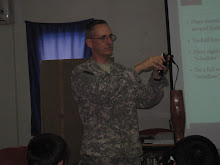
This photo is of a patient who came up to me about a bug bite problem. He didn't recall any bite, but the red spot had been present for about two months. He had casually inquired at the base clinic early in the process and was told to use some steroid cream on the spot, it should go away. He had done some research on the spot himself by the time he had come up to ask my opinion. I took one look and knew that a lesion like this; non-healing, ulcerated, red with a fresh looking scar was leishmaniasis. This photo was taken the day he went for specialty treatment for this problem.
Here in Afghanistan, the bite of the sand fly can carry any of several species of protozoa of the family Leishmania that can cause disease. It occurs in South America, Central America, the Mediterranean Sea, Subsaharan Africa, Southwest Asia(including Afghanistan) and India.
 There are three categories of Leishmaniasis: Visceral, Mucocutaneous, and Cutaneous.
There are three categories of Leishmaniasis: Visceral, Mucocutaneous, and Cutaneous.1. Visceral Leishmaniasis also known as Kala-azar, is more common in Subsaharan Africa, but can also be found in most areas of Europe bordering the Mediterranean Sea. Since Visceral Leishmaniasis occurs in areas with limited healthcare access the disease can result in fevers, ascites, and is fatal within 2 years if untreated.
2. Mucocutaneous Leishmaniasis affects primarily the mucus membranes of the nose, mouth and throat. These areas scar and can essentially collapse the face, resulting in severe socially limiting deformity.
3. Cutaneous Leishmaniasis is the 'best' type to get. Progression to one of the other categories of Leishmaniasis is possible but unlikely. My patient has cutaneous leishmaniasis. It generally persists for several months before diagnosis. In some cases it will resolve spontaneously leaving a large and unsightly scar in the area. In other cases, like above, treatment can help resolve the lesion faster. Even after effective treatment that heals the wound, reactivation of the disease can occur in some patients.
There are a variety of confirmatory tests for Leishmaniasis: Fluid aspirate cultures, tissue cultures and exams, enzyme tests. None of these are 100% accurate.
Cutaneous Leishmaniasis is very common in Afghanistan. So common that I heard parents in more remote areas will scratch some infected tissue into a cut on the leg of children so that they hopefuly won't get the lesion on their face. Cutaneous Leishmaniasis can result in the protozoa being transferred to other open wound areas - effectively spreading it to other parts of the body.
While different categories of Leishmaniasis are treated differently, it is curious how the USA differs greatly in treatment from the rest of the world. The most effective treatment for cutaneous disease are pentavalent antimony antibiotics. These effective but side effect riddled medications have been used since the 1940's, although resistance is on the increase. For cutaneous disease most other countries in the world, including Germany, use local injections of pentavalent antimony into the lesion daily for approximately 30 days. For US forces, this is not an option. A US servicemember who has cutaneous leishmaniasis must return to Walter Reed for 30 days of IV treatment with the pentavalent antimony drug (PENTOSTAM). The side effects of this drug are significant and potentially life threatening, so patients are hospitalized for the length of their treatment. Side effects can include the usual suspects of joint pains, GI upset and fatigue. The more concerning issues are electrocardiac abnormalities, anemia, elevated liver enzyme levels and low white blood cell counts. I am not sure why the CDC and Army chose this approach. It does have a good cure rate at 94%, but the potential for causing more harm that good is not subtle. Our German colleagues think we have lost our medical minds when we discuss the differences in treatment. Some antifungal drugs can also be used to treat cutaneous disease as well.
I wish I could say the gent who's leg is pictured is the first case I have seen among US forces here. I cannot. I have seen at least 5 cases in the few months. There are also many more cases among our Coalition partners here. I have only heard of one fatality due to visceral progression of a Coalition soldier a few years ago.
So while we think about the dangers of bombs and small arms fire, please also consider that US forces overseas are at risk for a variety of diseases we usually do not encounter at home. Disease and Non Battle Injuries (DNBI) are usually the highest percentage reason that military forces are not mission capable. Overall I think Coalition forces have done well to mitigate the many risks to our health here in Afghanistan.
The good news? Prevention is the best medicine. Wearing long pants and even shirts during dusk to dawn can prevent getting a bite. Also use of insect repellant. The simplest things are often the most effective, yet without constant vigilance, the most elusive.

Thank you so much! I knew our folks faced more than bullets and bombs but this makes it "realer." Bless you all!
ReplyDelete